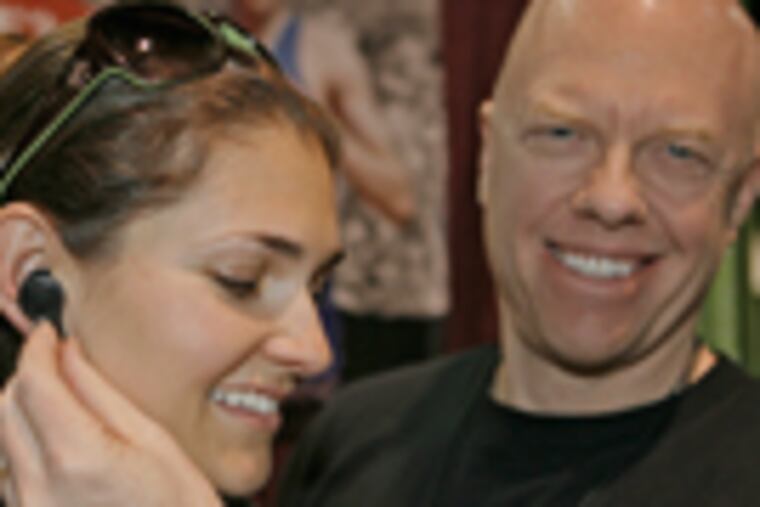Lend him your ears for better earphones
Auria L.L.C. founder David Lowry talks so much and so fast that listening seems the least likely area of interest for the Wayne inventor. Yet he's a downright fusspot when it comes to hearing, claiming to have "perfect-pitch ears."

Auria L.L.C. founder David Lowry talks so much and so fast that listening seems the least likely area of interest for the Wayne inventor. Yet he's a downright fusspot when it comes to hearing, claiming to have "perfect-pitch ears."
That, combined with "the gift to spot product faults," led him to a career-altering, bank-account-taxing conclusion three years ago: Earphones were lousy.
The 53-year-old mechanical engineer came to that determination not through complex scientific analysis, but through decades of personal experience: running and biking to music played through little speakers jammed in his ears.
Any of the earphones he used resulted in the same array of problems, including a painful fit, inability to hear ambient noise such as cars and trucks, sweat-induced slippage, and inferior sound quality.
To Lowry, whom one former associate described as a "make-it-happen-kind-of-guy," that was a call to action.
"I knew I had to develop something new to the world," he said.
That something: earphones that Lowry and other audio and sporting enthusiasts contend are unique in that they let wearers hear outside noises (they don't sit in ear canals like plugs), don't pop out (even in sweaty conditions), don't hurt, and offer high-quality audio through nanotechnology-based speakers.
Setting out on this inventive entrepreneurial course in the fall of 2007, as the recession was hitting, Lowry had to rely on his own financial resources.
"I've poured over seven figures into it," he said recently at Auria's headquarters in Malvern.
Still in the first year of its launch, and about to introduce a second-generation product line this week featuring some redesigns, Auria is not yet profitable but is logging monthly sales five times higher than they were in the spring, Lowry said. He would not disclose specific sales figures.
Lowry could afford to take this "pretty tricky" plunge because of previous success with another product most people do not think a lot about: positional-control devices. In essence, those are parts that allow a flat-screen television or computer monitor to be positioned at various angles.
After several years of engineering and technical-sales jobs with companies ranging from small start-ups to Westinghouse, Lowry, a 1979 graduate of Bucknell University, encountered the flat panel in the early 1990s and realized, "This is where the world is going."
He established CEMA Technologies Inc., of Philadelphia, in 1993 with the help of nearly $2 million in venture capital. He bought out his investors about five or six years later, and CEMA's sales grew to $20 million annually, with manufacturing facilities in Bridgeport and Audubon, Montgomery County, and Taipei, Taiwan.
Lowry said he was considering expanding to China when a buyout offer came from Southco Inc., of Concordville, Delaware County, in 2005.
What made CEMA an attractive acquisition was a constant-torque hinge that Apple and other computer manufacturers were using to ensure controlled movement of their laptop lids, said Brian McNeill, Southco's president and chief executive officer.
The privately held company of 2,500 employees in 70 countries and 70,000 customers already had a line of hinges, but we "wanted to accelerate our growth in that area," McNeill said.
Calling Lowry a "visionary and a dynamo," McNeill said he also is a man who "can look in a mirror and say, 'Here's what I'm good at; here's what I'm not good at.' "
What is not among Lowry's strengths, McNeill said, is the "greater processes and disciplines" needed to take a company global.
Lowry concedes that, saying: "I'm not the guy to run a stable business. I love building products."
This time, the biggest difference is that he is bringing a product to market. His previous work was developing things that became part of other companies' products.
"It's also about bringing a solution to certain types of athletes," Lowry said.
So last weekend, instead of gritting it out with 23,000 other runners during the Philadelphia Marathon, Lowry was logging miles in a 10-by-10 exhibit booth at the Convention Center during a two-day prerace running expo.
He demonstrated how Auria's earphones fit under portions of the outer ear canal, rather than inside the canal, where they can block out all sounds, creating a safety hazard. A continuous-play video showed Auria earphone wearers vigorously shaking their heads - and the earphones remaining firmly in place.
At booths nearby, competitors Yurbuds and SnuggBuds peddled more traditional earphones.
"Everyone likes something different," SnuggBuds representative Samantha Yadon said with a shrug when asked about the effect Auria might have on the already-crowded world of earphone wear.
Elyse Winer, 25, a health-care consultant with Vynamic L.L.C., of Philadelphia, opted for Auria, hoping to avoid last year's marathon horror, when her earphones deteriorated just two or three miles into the 26.2-mile endurance test.
"I panicked," she recalled. "I was relying on music to get me through the race."
This year, she ran the half-marathon, and in the little more than two hours it took her to finish, her new $30 earphones did what she needed them to do: painlessly stayed in her ears.
"I was pleasantly surprised," Winer said.
Lowry acknowledged that would not be the case for everyone. Certain ear shapes render his invention inadequate for about 10 percent of the running public.
"I've got something next year for the last 10 percent," Lowry said. That's when he also plans to take Auria global.
"This is human-factors engineering," Lowry said. "It's not just American ears."